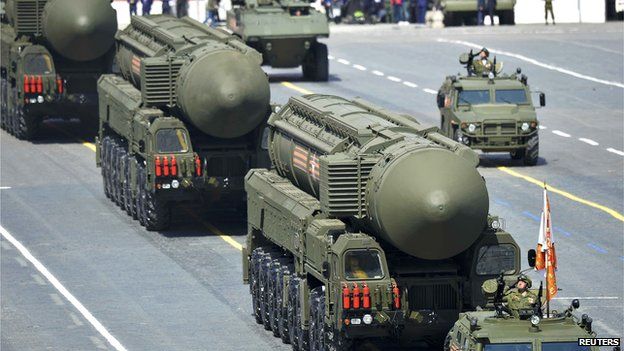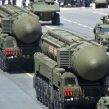
Russian Nuclear Weapons Policy Increasingly Resembles That of North Korea
Publication: Eurasia Daily Monitor Volume: 13 Issue: 148
By:

Moscow reacted harshly to North Korea’s most recent nuclear test. “Such explicit disregard for the norms of international law and the opinion of the international community merits the strongest possible condemnation,” the Russian Ministry of Foreign Affairs declared in a statement (Mid.ru, September 9). The irony, however, is that the nuclear weapons policy of North Korean dictator Kim Jong-un increasingly resembles the nuclear policy of Russia’s President Vladimir Putin. By illegally annexing Crimea from Ukraine and unleashing the “secret” war in Donbas, in 2014, Moscow entered into a military confrontation with the West. Meanwhile, North Korea is also confronting “American imperialism.” However, neither the Russian Federation nor the Democratic People’s Republic of Korea (DPRK—North Korea) have sufficient resources for such a confrontation. Indeed, Russia lacks the military and economic potential of the Soviet Union. Moreover, unlike the Soviet Union, Russia today has no real allies; the current demographic situation does not allow the formation of a five-million-strong Armed Forces; and Russian industry is no longer capable of mass producing conventional weapons.
The only resource that can compensate for these shortcomings is a robust nuclear arsenal. Of course, North Korea’s nuclear capabilities are not comparable either quantitatively or qualitatively with Russia’s. The DPRK possesses few “nuclear devices.” Russia, on the other hand, is the world’s second-largest nuclear power. At its disposal, Moscow wields 525 strategic launchers and 1,800 warheads. Even amidst an economic crisis, the Kremlin is carrying out at least two large-scale nuclear rearmament programs and preparing to start a third one. Specifically, the construction of “Project 955” Borei-class strategic nuclear submarines is continuing. At the same time, Russia is developing a new super-heavy thermonuclear-armed intercontinental ballistic missile, the RS-28 Sarmat (SS-X-30). In late August, Russian Defense Minister Sergei Shoigu inspected the development of industrial capacity of the Krasnoyarsk Machine-Building Plant, which is expected to produce the new missile (Mil.ru, August 27). In addition, during the forum “Army 2016,” Deputy Defense Minister Yuryi Borisov assured that were no technical obstacles to start production of the “Barguzin” (BZhRK ) railway nuclear missile system, and Russia would undertake this project if the political and military situation suddenly required it (Nezavisimaya Gazeta, September 8).
Yet, despite the scale of differences in their respective nuclear weapons programs, Moscow and Pyongyang have adopted similar goals for their nuclear arsenals. Traditional deterrence, typical for the Cold War, was based on the presumption that a potential aggressor would be discouraged from launching an attack by the threat of receiving unacceptably high retaliatory damage. Today, this kind of logic is insufficient to deal with the political pressure Moscow and other nuclear powers have been leveling on Western countries. As such, the international system has been seeing the revival of the doctrine of “extended deterrence,” first discussed in the late 1990s. This concept suggests that the very fact of possessing a powerful nuclear-strike capability plays a decisive role in resolving any international problems. Russia (and the DPRK) threatens to use nuclear weapons if it sees its interests infringed upon (see EDM, November 18, 2013; Ukraine Today, December 16, 2015; Independent, April 1, 2015; The Korea Times, August 8, 2014). But neither government clearly defines what would constitute such an infringement.
Such a policy inevitably requires regular reiterations of a readiness to use nuclear weapons. That is why Defense Minister Shoigu promised that Russian strategic bombers would conduct regular “combat patrols,” even in the Gulf of Mexico. Russia is, thus, reviving the gloomiest scenarios of the Cold War. During the onset of the crisis in Ukraine, the Kremlin conspicuously brought up the Soviet-built “Perimeter” system, designed to launch Russian missiles in automatic mode, even if a sudden decapitation strike destroys all of Russia’s command centers (in the West this system is often referred to as the “Dead Hand”) (Rossiyiskaya Gazeta, January 24, 2014). Later, the Kremlin “leaked” another “top secret” project, called “Status 6.” During a press briefing featuring top military generals and the Russian president, two national television channels “accidentally” showed a slide describing a top-secret “doomsday” weapon intended to “destroy important economic installations of the enemy in coastal areas and cause guaranteed devastating damage to the country’s territory by creating wide areas of radioactive contamination, rendering them unusable for military, economic or other activity for a long time” (see EDM, November 12, 2015; Newsru.com., November 13, 2015).
Nuclear weapons are an effective element of political pressure only if complemented by a proven madness of their owner, however. The Soviet nuclear potential was, therefore, an important tool of foreign policy because Washington perceived “the Kremlin elders” to be insane and unpredictable. Erratic behavior has been a central feature North Korea’s ruling dynasty for decades. And Putin has seemingly been learning from the Kims. In recent years, the Russian leader has repeatedly strongly hinted at his readiness “to push the button” if needed.
Appearing in the TV documentary Crimea: The Way Home, about Russia’s military operation to annex the peninsula, Putin said that at the time he was ready to raise the status of the Russian nuclear forces to combat readiness: “We were ready to do it. I talked to colleagues and told them that it [Crimea] is our historical territory; Russian people live there; they were in danger; we cannot abandon them” (Vesti.ru, March 15, 2015).
Later, in another propaganda film, The World Order, which covered the October 2015 launches of Russian Kalibr cruise missiles against targets in Syria, Putin stressed this act proved Russia possesses powerful weapons and has the will to use them, “if it meets the national interests of our state and the Russian people” (Kremlin.ru, October 12, 2015).
At the same time, the president clearly believes the West wants to deprive Russia of its nuclear weapons. He describes Russia as a bear whom “someone will always try to chain up. As soon as he is chained, they will tear out his teeth and claws. In this analogy, I am referring to the power of nuclear deterrence. As soon as—God forbid—it happens and they no longer need the bear, the taiga will be taken over” (Kremlin.ru, April 16, 2015).
The transformation of nuclear weapons into a major foreign policy tool unites Vladimir Putin and Kim Jong-un. Both leaders are doomed to constantly raise the stakes in their international confrontations. But Russia has a thousand times more nuclear warheads than North Korea. When Kim blackmails his neighbors with a few warheads, it could lead to a regional disaster. Nuclear blackmail by Moscow could destroy the planet.




